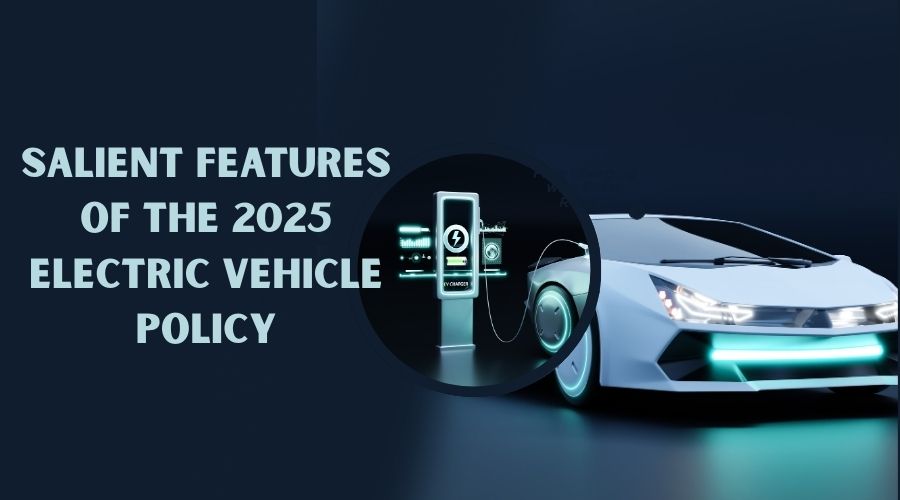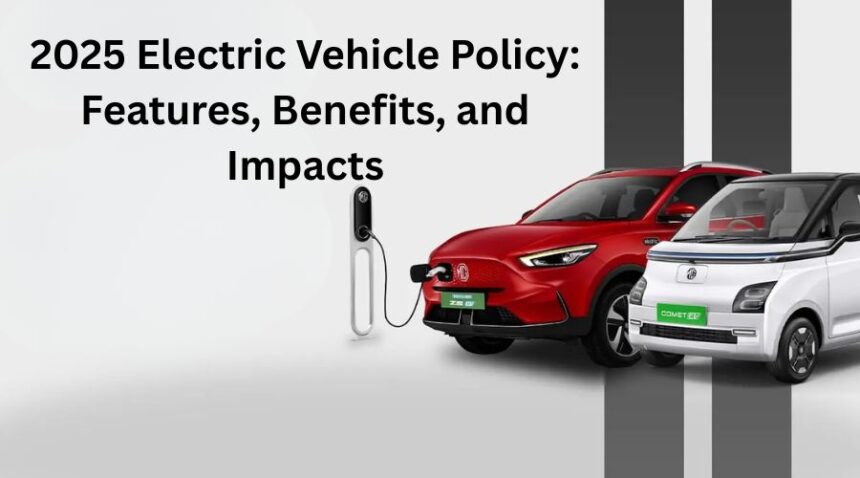The 2025 Electric Vehicle Policy is a plan that has been made strategically by the Government of India to increase the domestic production of electric vehicles. This will lead to lower import taxes and promote foreign investments. This will also help in achieving the higher objectives like controlling carbon emissions and less import of oil, leading India to be a global leader in the electric mobility segment.
Latest Update on EV Policy 2025
The EV policy benefits were extended by the Delhi government from October 2024 to March 2025. The policy covers subsidies for electric two- and three-wheelers, e-cycles, and e-light commercial vehicles. This step will increase the adoption of EVs and limit urban pollution.
The Madhya Pradesh government unveiled its EV policy on 24th February, 2025. It offers subsidies from ₹5000 to ₹10 lakhs on various electric vehicle categories. In this 5-year policy, the aim is to adopt specific EVs, including 15% for 4-wheelers and 40% for two-wheelers, by 2030.
Key Facts On EV Policy 2025
| Features | Details |
| Scheme Name | New Electric Vehicle Policy 2025 |
| Launch Date | March 15, 2024 |
| Implementation Ministry | Ministry of Commerce & Industry |
| Minimum Investment | ₹4,150 crore (approx. USD 500 million) |
| Import Duty (EVs) | 15% on up to 8,000 fully built EVs per year |
| Import Cap | 8,000 EVs per year (with carry-forward allowed) |
| Domestic Value Addition (DVA) | 25% in 3 years, 50% in 5 years |
| Manufacturing Requirement | The company must set up a local EV production facility in India |
| Target Segment | Premium and high-end electric vehicles |
| Main Goal | Make India a global hub for EV manufacturing |
The Electric Vehicle Policy of 2025 was approved by the Union Cabinet in MARCH 2025. The policy aims to encourage EV manufacturers to invest and make vehicles in India. This will make the country a strong hub for electric vehicles, similar to how India became the IT leader.
Under this policy, the companies are allowed to import only limited fully manufactured electric vehicles (CBUs) at an import rate of 15% (reduced from 70% and more). However, to avail the subsidy, they have to invest at least ₹4,150 crores for building a manufacturing unit in India. These units are expected to make 25% of the parts in India within 3 years, which will eventually increase to 50% by 5 years.
The Indian government aims to create a strong EV ecosystem rather than bringing in any new EV vehicles.
Salient Features of the 2025 Electric Vehicle Policy:

The policy will bring a huge turning point in the EV sector in India. Here are some highlights:
– Lower Import Duty
At a reduced customs duty of 15% for 8000 units, companies can import vehicles. This can be followed only when they invest in the Indian manufacturing unit.
– Minimum Investment Required
Any company that is planning to import an electric vehicle should make a minimum investment of ₹4,150 crores in setting up manufacturing plants.
– Local Manufacturing Timeline
As per the policy, local manufacturers may start developing 255 of the vehicle parts within 3 years of establishment. This should eventually grow to 505 within 5 years.
– Domestic Value Addition (DVA)
As per the target of DVA, it is to be ensured that not only is assembling done in India, but also the key components are created.
– Import Limit
Around 8,000 electric mobility devices can be imported annually. The parts that are unused can be carried forward to the next year.
– Bank Guarantees
To keep the investment promises intact, the policy includes bank guarantees, which can be forfeited if the targets are not met.
– High-End EVs Are Focused
The policy targets mainly the premium brands of electric vehicles, such as Tesla, VinFast, and BYD. This opens up the global players to make an entry into the Indian electric mobility segment.
Key Impacts the New EV Policy Will Have:
The new electric vehicle policy will make major impacts on different sectors and people in India. Here are some to look for:
– Make In India Boosted
As the policy gives a push to global companies in creating their manufacturing units in India, the domestic production boom will help in promoting the “Make in India” campaign.
– Creating Employment
With new factories and manufacturing units setting up, many employment opportunities will be unveiled in sectors like engineering, manufacturing, and services.
– Transfer Of Technology
India will see a boom in the technology sector, as with global EV players, advanced technology will also make its way into the domestic market.
– Pollution Free Environment
With more electric vehicles on the road, air pollution and carbon emissions will be curbed.
– Lower Oil Imports
As the usage of EVs rises, the demand for oil will go down in the Indian automobile market, which will eventually save foreign exchange.
Advantages Of the New Electric Vehicle Policy
Here are some benefits of the policy:
– Growth In the Economy
Because of the investment plans in the manufacturing factories, economic development will see faster growth.
– Protection Of the Environment
With the reduction of carbon emissions, India will be able to achieve its climate goals.
– Choice Of Consumers
After a considerable period, buyers will get a variety of EV choices, including high-end and luxury models.
– Development In Infrastructure
Better roads, more charging stations, and energy grids will be created to support EVs.
– Position In the Global Market
With both manufacturing and innovation units rising, India will become a prominent leader in EVs.
Cons with the Policy
No matter the benefits, there are challenges with the EV Policy:
– Costly Initials
In comparison to regular petrol and diesel vehicles, EVs are quite expensive.
– Issues With Battery Supply
In today’s time, India is still dependent on other countries like China for Lithium-ion batteries.
– Infrastructure For Charging
In rural areas, the charging infrastructure is still unavailable.
– Demand For Electricity
With the rise in demand for electric vehicles, electricity needs will be high, putting pressure on the power grid.
– Manpower Shortage
Indian manpower needs more skilled and trained workers to work on EVs.
– Implementation of Policy
It might get a bit difficult to ensure all the global companies follow the policy promises.
EV Market In India

As per the early 2024 reports by the Ministry of Heavy Industry (overseeing the FAME Scheme), around 1.6 million electric vehicles are supported by the subsidies provided by various schemes in India. In the number mentioned above, you will find electric 2-wheelers, 3-wheelers, and cars.
Electric Mobility is seeing a steady increase in its sales graph. In the financial year of 2023-24, approximately 1.5 million EVs were sold in India. In this data, two-wheelers and three-wheelers are leading the way.
There are many domestic and international companies that are investing in the manufacturing of electric vehicles and batteries in India. The list includes the names of big brands.
The Indian government supports the rise of EVs through schemes like FAME (Faster Adoption and Manufacturing of Electric Vehicles), which encourages people to buy EVs. The state government is also playing its role in promoting electric vehicles with their policies.
Although the market is growing, electric vehicles still make up a small percentage of the Indian automobile market. The potential to grow is larger in the coming years.
Other Initiatives for EV Industry
Several other schemes support India in becoming the EV global leader:
– FAME Scheme (Faster Adoption and Manufacturing of Hybrid and Electric Vehicles)
Beginning in 2015, subsidies to EV buyers were provided, and charging infrastructure was supported. The FAME-II was extended to March 2024, with a ₹10,000 crore budget.
– PLI Scheme For Automobile and Auto Components
Provides incentives to companies for making EV parts in India.
– Battery Swapping Policy
This was introduced by NITI Aayog, which makes charging quicker and easier.
– State-Level EV Policies
There are many states like Delhi, Maharashtra, and Tamil Nadu that have their own EV subsidies and road tax waivers policy for promotions.
– Development Of Charging Infrastructure
With the rise in demand for EVs, the government plans to set up more charging stations for the public and provide land at a lower cost to set up the grid.
FAQs
Q1. Who is eligible for the Fame-II subsidy?
Ans: Any buyer who buys an EV that has been approved by the FAME-II list is qualified. There are requirements for the vehicle’s speed, range, and localization.
Q2. What is the new EV policy of 2025 in India?
Ans: Companies that invest at least ₹4,150 crore in constructing plants in India and satisfy local production targets are eligible to import EVs at a 15% tariff reduction under the New Electric Vehicle Policy 2025.
Q3. Which companies should be expected to benefit from the policy?
Ans: Under the new regulation, international EV manufacturers like VinFast, BYD, and Tesla could enter or grow in India.
Q4. What is Domestic Value Addition (DVA)?
Ans: DVA refers to the production of automobile components in India. To maintain the benefits of import duties, the policy stipulates that 25% DVA must be paid in three years and 50% in five.
Q5. How can one claim the EV subsidy?
Ans: Through the car dealership, you are eligible to get an EV subsidy. At the moment of purchase, it is subtracted from the total cost. Make sure the car has been approved under the FAME program.






